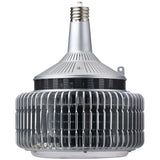Evaluating an LED Retrofit of HID High Bay Fixtures in a Maintenance Facility
Posted by Dave on for ProLampSales

The Lighting Research Center (LRC) at Rensselaer Polytechnic Institute has conducted a field research project evaluating installation issues and performance of a high bay retrofit where the existing metal halide bulbs have been changed to LED.
High bay fixtures that use metal halide lamps in warehouses, shops, sports facilities and big box retail offer an opportunity for significant energy savings with LED HID replacement lamps. The high wattages for metal halide range from 175 watts to 400 watts and higher. Most of these high wattage bulbs utilize mogul (E39) bases.
The LRC's objectives were:
- Assess the ease of the retrofit
- Compare worker attitudes about the lighting both before and after the retrofit
- Evaluate the energy performance before and after the retrofit
The facility in the study, a Bonneville Power Administration (BPA) maintenance shop located in the Pacific Northwest, utilized Philips mogul based, 400W metal halide. The fixtures were dome reflectors with diffusers.
Light Efficient Design 148W LED lamps were installed as ballast by-pass type replacements for the metal halide.

Existing: Philips Mh300/U/ED28
- Lumens: 24,000 (mean)
- Color Temp: 4000K
- Color Rendering: 63 CRI
- Rated Life: 20,000 hours
Replacement: Light Efficient Design LED-8090M40-A
- Lumens: 15,000
- Color Temp: 4000K
- Color Rendering: 84 CRI
- Rated Life: 50,000 hours
The retrofit steps included removal of the existing lamps, removing the existing ballasts, rewiring the line voltage to the sockets, installation of a surge protector to safeguard the LED electronics, installation of a fast-acting fuse to protect against an explosion in case a conventional HID lamp is latter installed without reconnecting a ballast.
According to the electrician who performed the retrofit, the time to complete all the steps above for each fixture was 15 minutes. A bucket truck was used to access the fixtures. According to the LRC report, the electrician noted that the time for this retrofit was less than the time required to remove the existing high bay fixture and install a new, dedicated LED high bay fixture.
Summary of Results
Illuminance
The newly cleaned and LED retrofitted fixtures increased light levels by a factor of 3x.
Prismatic lenses used before and after the retrofit, improved light distribution and softened shadows.
Worker Response
An anonymous questionnaire was provided to workers both before and after the retrofit.
None of the light features addressed on the questionnaire were rated worse after the retrofit; all were rated equal or better.
After the retrofit workers noted higher light levels and brighter working conditions than before.
Energy
Before the retrofit the lights were frequently left on overnight. The researchers speculated that one reason could have been to overcome the restrike delay with metal halide in the morning when workers arrive. This overnight operation obviously added to the electric energy costs before the retrofit. After the retrofit, the researchers found that the lights were not left on overnight (LED is an instant-on light source).
The annual kWh savings was estimated at 60% after the retrofit. Not including lower long term maintenance costs, the payback period for this project was estimated at 9.5 years. The costs included in the payback calculation included the LED lamps, surge protectors, fuses, labor and equipment rental.
This relatively long payback period was attributed to:
Low annual hours of fixture use because of daylight penetration through clerestory windows in the space. Intermittent occupancy also reduced the use of the electric lighting.
Low electricity rates where this facility is located – much lower than the U.S. average.
The high cost of LED lamps compared to metal halide (this study was done in May of 2016).
Conclusions & Recommendations
LED high bay retrofits should definitely be evaluated for the potential energy and maintenance savings over the long term. Care should be taken in understanding the existing cost of electric lighting with the HID lamps so that a reasonably accurate comparison can be made with LED.
Facility managers should thoroughly research and compare the LED lamp options available including lumen output, rated life, price and warranty.
Note: The type retrofit used in this study was ballast bypass. Another approach worth evaluating is using LED lamps that are ballast compatible. This approach should save some installation time.
The LRC study noted that the high bay fixtures were long overdue for a cleaning. As part of any retrofit evaluation, it would be worth comparing the LED retrofit with one where the fixtures were cleaned and new metal halide lamp installed. This alternative approach will be less expensive and certainly improve the illumination in the space, but without the energy savings and reduced maintenance achieved with LED.
- Posted in HID & Metal Halide, LED, Retrofits, Warehouses
Featured Products (View All)
0 Comments




